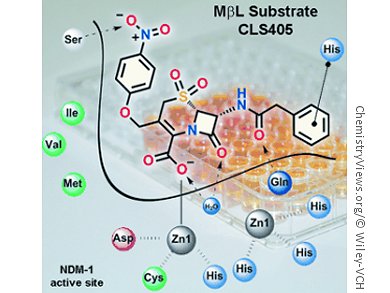The use of β-lactam antibiotics is currently threatened by both serine- and metallo-β-lactamases (SBLs and MBLs), which render these drugs ineffective. MBLs in particular are an increasing public health concern because they can hydrolyze nearly all β-lactam antibiotics, with the exception of monobactams. Although several clinically relevant SBL inhibitors have been developed, no clinically useful MBL inhibitors have been reported thus far.
Along with their collaborators, Chris Schofield and co-workers at the University of Oxford, UK, have developed the novel chromogenic substrate CLS405 (pictured) suitable for assaying clinically relevant MBLs. Use of this assay platform for inhibitor screening resulted in the identification of a novel low-micromolar hydroxythiazole-based MBL inhibitor, paving the way for the development of more candidate compounds that can fill this void.
- Chromophore-Linked Substrate (CLS405): Probing Metallo-β-Lactamase Activity and Inhibition,
Anne Makena, Sander S. van Berkel, Clarisse Lejeune, Raymond J. Owens, Anil Verma, Ramya Salimraj, James Spencer, Jürgen Brem, Christopher J. Schofield,
ChemMedChem 2013.
DOI: 10.1002/cmdc.201300350




